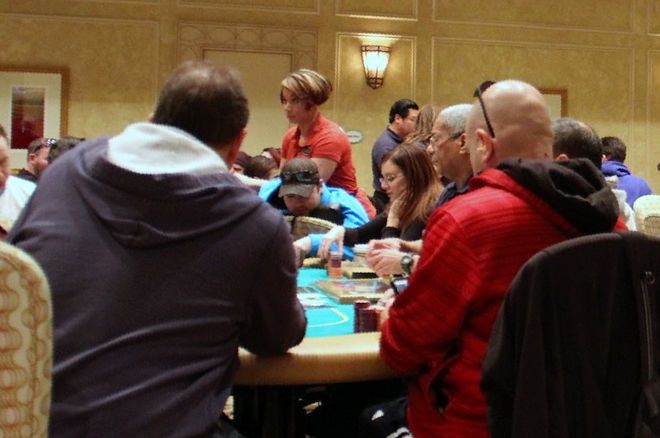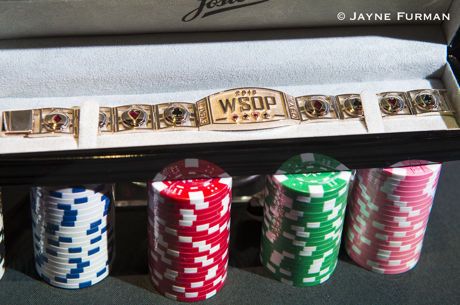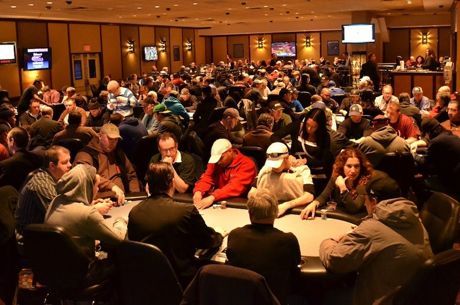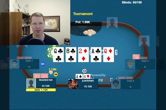His and Hers Poker: High and Dry

Hello, Poker Friends! This week we are going to examine a common spot in which many players struggle to maintain balance: very dry boards.
The Table and Villain(s)
We're at a $2/$5 table at the Borgata. The main Villain is in the hijack. Villain is a recreational player in his 30s. His play is fairly straightforward, with his bet sizes often indicative of the strength of his holding. Like many $2/$5 players, he continuation bets too much on the flop, but seems to get honest on the turn.
Hero (Matt) is on the small blind. Hero has had cold cards for several hours and has not three-bet preflop for that entire time. Overall, his table image is likely very tight.
Effective Stacks: ~$1,000 (Hero).
Preflop
Action
It folds around to the Villain in the hijack seat, who opens to $25. The cutoff and button fold. Hero is in the small blind with A?K? and elects just to call. The big blind folds and we go heads-up to the flop.
Analysis
It pays never to do anything in poker on "autopilot." Certainly, our first thought with A?K? is going to be a three-bet. However, is there an argument to be made for simply calling here? Definitely. Our table image is extremely tight. If we three-bet, we stand to get an inordinate number of folds from holdings which our hand is dominating. It may be better to call and try to extract more money from those hands postflop.
Does that mean we're advocating calling with AKs from all positions when our image is tight? Absolutely not. This is a special situation. Why? To answer that question, we need to remember one of the primary reasons we three-bet �� isolation.
If we have AKs in middle position, we should three-bet that every time. We do not want to run the risk of having our premium hand's value evaporate in a six-way pot. Here, however, the worst that can happen is the big blind calls behind us and we see a three-way flop. That's not a bad outcome, and it is likely better than missing the chance to obtain more value postflop with a hand as good as A?K?.
Flop
Action
With $55 in the pot, the flop comes J?5?2?. Hero checks and Villain bets $40. Hero calls.
Analysis
This flop is dry as a bone and we know that Villain chronically over c-bets. That means that Villain is c-betting with a ton of air on this board. That should lead us to at least call one street with A?K?, which beats all unpaired hands.
Is there any merit to raising, however? Many low stakes players would raise only one type of hand on this dry board �� sets. Since there are no obvious flush or open-ended straight draws available, their raising range would be entirely for value. That's not a good thing, as it is completely unbalanced. We should attempt to have some bluff combos to balance out our value combos every time we bet or raise.
So if we would raise our sets here, what should our bluffs be? Do we need to use our A?K? as a bluff?
When selecting bluffs, we should start with hands that have decent draws, but which have the least amount of showdown value. We'd love to be able to raise with 43, but we probably didn't call preflop with that. Our next best candidates are A4s and A3s, which have a gutshot. If we only use the combos of A4s and A3s which also have a backdoor flush draw, that's six combos of bluffs. If we would raise the flop with 55 and 22 for value (presuming we would have three-bet JJ preflop) �� that's six value combos. That seems pretty balanced!
It looks like we don't need to use A?K? as a bluff. Instead, we can use our current holding as a bluff catcher for the many times when Villain is c-betting with air.
Turn
Action
With $135 now in the pot, the turn brings the Q?, for a board of J?5?2?Q?. Hero again checks to Villain who bets $65. Hero check-raises to $200. Villain folds.
Analysis
We have two compelling reasons to bluff here on the turn. The first is, again, in the name of balance. We could easily hold all nine remaining combos of QJ here, which we would want to raise for value. We need some bluffs to balance that out.
We don't have many hands that called the flop which are now a decent draw on this turn. AK is about it. A?K? is obviously our best candidate for equity, but that's only one combo. For the rest, if we use combos of AK without a heart, that will increase the likelihood that Villain is betting the turn with a flush draw which may lay down to our check-raise. That comes out to a total of 10 bluff combos, including our A?K?.
Second, from a purely exploitative standpoint, this looks like a good bluffing spot against this particular opponent. Villain followed up a roughly 3/4-pot sized bet on the flop with a less than half-pot sized bet on the turn. From a straightforward player who sizes bets in accordance with his hand strength, that looks like someone with a weak jack praying that we don't have a queen or better.
We should be able to generate a good deal of fold equity here, particularly since our table image is rather tight. If we get called, we may have as many as 10 outs to fall back upon.
The Takeaway
When the board is particularly dry, you may need to reach deep to find good bluffing candidates. You should make the effort to do so, however. Failure to bluff enough will leave you "high and dry" on these boards. Your opponents will know you are only raising for value, which will reduce the amount you can obtain with your premium holdings.
His and Hers Poker is a free, weekly strategy podcast hosted by Matt and Tracey Waldt. They are a married couple who play live cash games on the East Coast. Their podcast focuses on providing practical advice about hand reading, with an emphasis on how to identify and exploit the common leaks and imbalances of low-stakes players. His and Hers Poker can be found on iTunes, Google Play and other podcast services. For more information, and to subscribe, please visit hisandherspoker.com.








